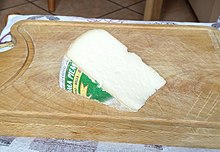
Toma is a soft or semi-hard Italian cow's milk cheese, noted for its excellent melting qualities. It is made primarily in the Aosta Valley (it is one of the region's specialties[1]) and Piedmont regions of Northwestern Italy. Toma varies with region and locale of production, and is closely related to the French tomme.
The Toma piemontese variety from Piedmont has Protected Designation of Origin status under EU legislation, while the Toma di Gressoney or Tomme de Gressoney (French), produced in the Gressoney Valley, is officially recognized as a prodotto agroalimentare tradizionale and is included in the Ark of Taste catalogue of heritage foods.
Toma is not very common in Central and South Italy, with Basilicata as the only main producer. The Toma Lucana is also recognized as a PAT.[2]
It can have a fat content of 45%–52%.
See also
[edit]References
[edit]- ^ Anderson, Burton (2001). The Foods of Italy (5 ed.). Italian Trade Commission. pp. 127–29. ISBN 978-1-4507-5291-6.
- ^ Ministero Politiche Agricole Alimentari Forestali e Del Turismo. "Diciottesima revisione dell'elenco dei prodotti agroalimentari tradizionali".
External links
[edit]- Disciplinare di produzione (in Italian)
Well, that’s interesting to know that Psilotum nudum are known as whisk ferns. Psilotum nudum is the commoner species of the two. While the P. flaccidum is a rare species and is found in the tropical islands. Both the species are usually epiphytic in habit and grow upon tree ferns. These species may also be terrestrial and grow in humus or in the crevices of the rocks.
View the detailed Guide of Psilotum nudum: Detailed Study Of Psilotum Nudum (Whisk Fern), Classification, Anatomy, Reproduction